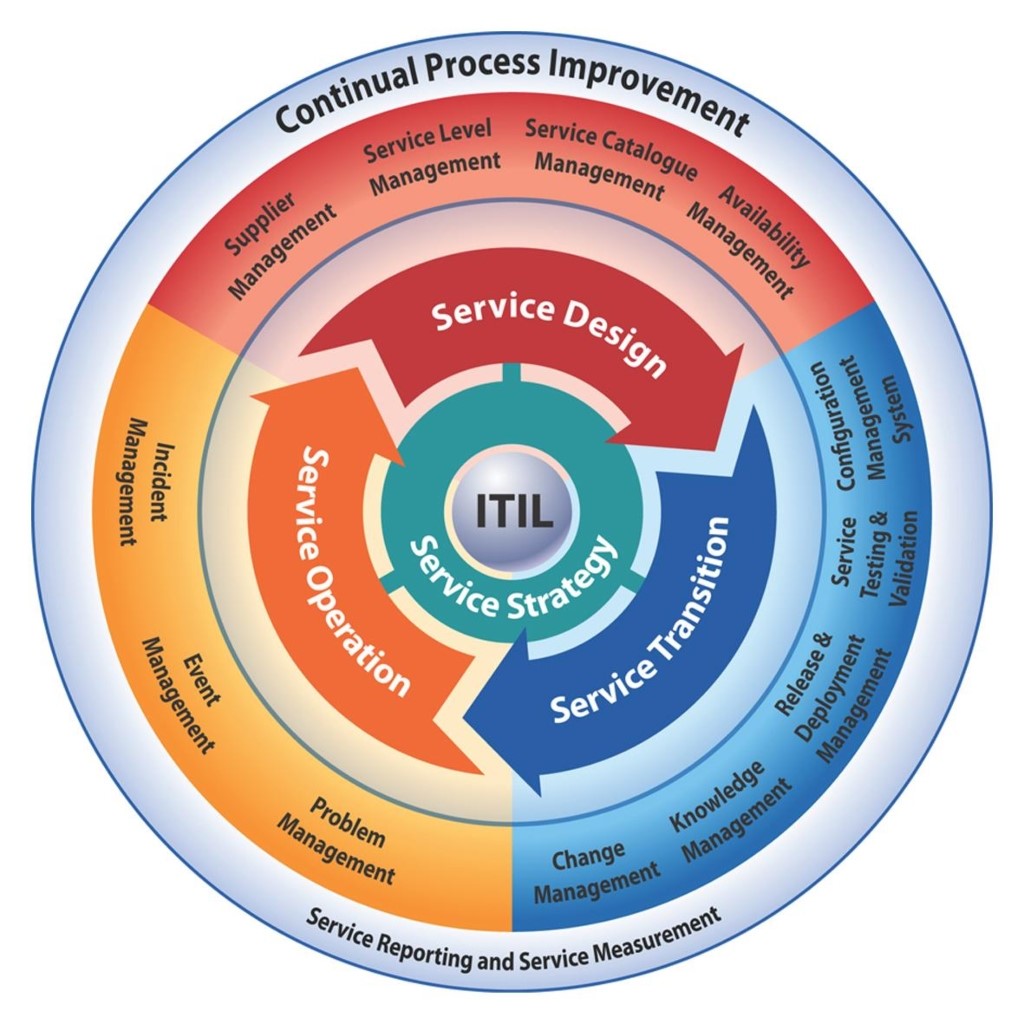Being able to “talk service” is an important part of the role of an IT architect so I’m currently studying for my IT Infrastructure Library (ITIL®) Foundation certification.
At the time of writing, I haven’t yet sat the exam (so this post doesn’t breach any NDA) but the notes that follow were taken as I studied.
About ITIL
There are various ITIL introductions on the Internet – this video is the one from Axelos, the joint venture between Capita and the UK Cabinet Office, who administer ITIL (and PRINCE) and it’s really just an advert…
https://www.youtube.com/watch?v=s4VH0A687lg
For a better understanding of what ITIL is, try this:
Certification
ITIL certification is available at several levels (foundation, practitioner, intermediate, expert and master) with foundation being the entry level. The ITIL Foundation syllabus details the information that candidates are expected to demonstrate to be successful in the exam.
Axelos has published three “top tips” articles around the ITIL Foundation certification:
There are also sample exam papers available as well as an Official ITIL Exam app available for testing your knowledge.
ITIL Overview
IT Service Management is:
“The implementation and management of quality IT services that meet the needs of the business. IT service management is performed by IT service providers, through an appropriate mix of people, process and information technology.”
ITIL is an IT Management framework showing best practices for IT Service Management. It’s a library of 5 books (and other resources):
- Service Strategy.
- Service Design.
- Service Transition.
- Service Operation.
- Continual Service Improvement (CSI).
There is also complementary guidance (e.g. release control and validation) – broken out by industry vertical (e.g. health, government) or by technology architecture (e.g. cloud, networking, software).
Basic terminology
- Baselines – starting points/reference point. Used to look back or get back:
- ITSM Baseline – measure service improvement plan (SIP).
- Configuration Baseline – used for remediation/back-out from change.
- Performance Baseline – response before made service improvement.
- Business case – justification for spending money (planning tool):
- Costs.
- Benefits.
- Risk.
- Potential problems.
- Capabilities – ability to carry out activities (functions and processes)
- Functions – team of people and tools carrying out activities:
- Who will do something – e.g.:
- Service Desk.
- Technical Management.
- Application Management.
- IT Operations Management.
- Who will do something – e.g.:
- IT Service Management – capabilities providing value to customers in the form of services.
- Process – co-ordinated activities to produce an outcome that provides value:
- How to do something.
- Process Owner vs. Manager
- Owner is responsible and accountable for making sure process does what it should.
- Manager is responsible for operational management of the process (reports to the owner).
- Resources:
- IT infrastructure.
- People.
- Money.
- Tangible assets (used to deliver service, cf. capabilities which are intangible).
- Service – means to deliver value
- Manage costs on the provider side whilst delivering value to the customer.
- Service will have a service strategy.
- Service owner – responsible for delivering the service. Also responsible for CSI.
ITSM and Services
- Organisation has strategic goals, objectives
- Core business processes are the activities that produce results for the organisation (reliant on vision)
- IT service organisation – to execute on core business processes.
- IT service management – repeatable, managed and controlled processes to deliver service
- IT technical – computers, networking, etc.
Each layer supports the levels above.
Services:
“A means of delivering value to customers by facilitating outcomes customers want to achieve without the ownership of specific costs or risks”
Processes and Functions
Processes:
“A structured set of activities designed to accomplish a specific objective. A process takes one or more defined inputs and turns them into defined outputs.”
- Trigger.
- Activity.
- Dependency.
- Sequence.
Processes:
- Are measured.
- Have specific results.
- Meet expectations.
- Trigger change.
Processes have practitioners, managers and owners (accountable for making sure the process is fit for purpose, including definition of the process).
Functions:
“Grouping of roles that are responsible for performing a defined process or activity.”
- Service Desk.
- Technical Management.
- Applications Management.
- Facilities Management.
- IT Operations Control.
Functions interact and have dependencies.
Responsibility Assignment Matrix (RAM chart) – e.g. RACI:
- Responsible.
- Accountable.
- Consult.
- Inform.
Map processes and roles.
ITIL Service Lifecycle
Earlier versions of ITIL used to focus on the processes. Version 3 focuses on why those processes are necessary. For foundation level, candidates need to know the objectives, rather than the detail.

The idea to provide a service will be conceptualized, then it will be designed, it will transition, and be maintained through operation. Always looking for ways to improve a process or service for customers (and deliver more value).
Services will be born and also retired (death).
The service catalogue details the things on offer, together with service levels.
The table below shows the processes for each stage within the ITIL service lifecycle:
| Service strategy | Service design | Service transition | Service operation | CSI |
|---|---|---|---|---|
* Not required at foundation level |
|
* Not discussed in detail at foundation level |
Processes:
Functions:
|
7 step improvement plan |
The next post in this series will follow soon, looking at service strategy.
These notes were written and published prior to sitting the exam (so this post doesn’t breach any NDA). They are intended as an aid and no guarantee is given or implied as to their suitability for others hoping to pass the exam.
ITIL® is a registered trademark of Axelos limited.
6 thoughts on “Preparation notes for ITIL Foundation exam: Part 1 (overview/introduction)”